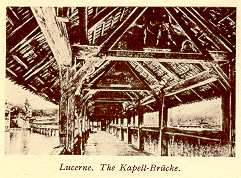
Is there a more delectable town than Lucerne? Everything about it is
pleasing: the waters of the Lake which touch it with a caress, the buildings of bygone
times and the more showy constructions of our own, the urbanity of the men and the
gracefulness of the women, of whom Bourrit said that they were well-built and well-bred.
It extends along the banks of the Lake and of the Reuss and ends in a corner of a green
valley.
The Reuss flows past the town with the swiftness of a torrent, spanned
by a modern bridge which resists it stolidly, but it hammers vigorously against a wooden
bridge which, to all appearances, would be swept away were it not securely moored by the
octagonal Wasserturm with its thick walls and conical roof. Its piles and timberwork are
probably the only surviving remains of the old lake-dwellings, and it crosses the river in
a crooked line, following, more or less, the lie of the ancient town.
Once upon a time, it ran right up to the steps of the cathedral,
crossing a bay which has been filled in and is now the site of various hotels. In this
bridge, the Kapell-Brücke, the entire history of Lucerne, religous and political, may be
said to be embodied. In the wood-work of its roof are panels on which are represented all
the chief events in its annals, scenes from the lives of its patron saints, battle-scenes,
the unfurling of banners, apparitions, the scene of the solemn oath at Rütli, the great
fire of 1400. It is both pleasand and touching to hear some native of Lucerne explaining
these pictures to the tourist.
Downstream, on another and very similar bridge, the Speuer-Brücke, or
Mühlen-Brücke, there is a watch-tower in pink stone jutting out into the stream and
dedicated to the Virgin. This bridge is remarkable for a series of paintings of the Dance
of Death, executed by Gaspard Meglinger: all sorts and conditions of men and women,
priests and warriors, princes and men of learning, the young bride, the devout nun, the
lawmaker, the hunter, the miller, the artist himself, are depicted at the mercy of Death,
with his mocking smile and his ever-changing garb--pictures suitable for a Benedictine
Abbey, which are seen by every inhabitant of delectable Lucerne who crosses the river by
that bridge.